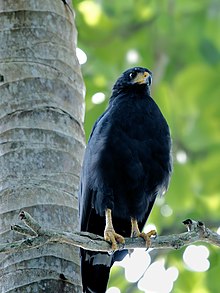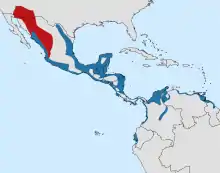| Common black hawk | |
|---|---|
 | |
| Common black hawk in Costa Rica | |
| Scientific classification | |
| Domain: | Eukaryota |
| Kingdom: | Animalia |
| Phylum: | Chordata |
| Class: | Aves |
| Order: | Accipitriformes |
| Family: | Accipitridae |
| Genus: | Buteogallus |
| Species: | B. anthracinus |
| Binomial name | |
| Buteogallus anthracinus (Deppe, 1830) | |
| Subspecies[2] | |
| |
 | |
The common black hawk (Buteogallus anthracinus) is a bird of prey in the family Accipitridae, which also includes the eagles, hawks, and vultures.
Description
The adult common black-hawk is 43–53 cm (17–21 in) long and weighs 930 g (33 oz) on average. It has very broad wings, and is mainly black or dark gray. The short tail is black with a single broad white band and a white tip. The bill is black and the legs and cere are yellow. The adults resemble zone-tailed hawks, but have fewer white bars on their tail and are larger in size.
Sexes are similar, but immature birds are dark brown above with spotting and streaks. Their underparts are buff to whitish with dark blotches, and the tail has a number of black and white bars.
Subspecies
It formerly included the Cuban black-hawk (Buteogallus gundlachii) as a subspecies. The mangrove black hawk, traditionally considered a distinct species, is now generally considered a subspecies, B. a. subtilis, of the common black-hawk.[3]
Distribution and habitat
The common black-hawk is a breeding bird in the warmer parts of the Americas, from the Southwestern United States through Central America to Venezuela, Peru, Trinidad, and the Lesser Antilles. It is a mainly coastal, resident bird of mangrove swamps, estuaries and adjacent dry open woodland, though there are inland populations, including a migratory population in north-western Mexico and Arizona.
Behaviour
Breeding
The bird builds a platform nest of sticks fifteen to one hundred feet above the ground in a tree, often a mangrove. Nests are often reused and tend to grow bigger. It lays one to three eggs (usually one), which are whitish with brown markings.
It has hybridized naturally with the red-shouldered hawk (Buteo lineatus) in Sonoma County, California, USA.[4] This natural hybridization between different genera of hawks is rare.
Feeding
It feeds mainly on crabs (especially land crabs) and crayfish, but will also take small vertebrates (such as fish, frogs, turtle hatchlings, lizards, snakes and small, young or injured birds and mammals), carrion (in form of dead fish) and eggs.[5][6][7] The common black hawk also supplements its diet with a variety of insects, including grasshoppers, caterpillars and wasp larvae.[5][6][8] This species is often seen soaring, with occasional lazy flaps, and has a talon-touching aerial courtship display. The call is a distinctive piping spink-speenk-speenk-spink-spink-spink.
Status and conservation
The common black hawk is protected in the far north of its range (in the USA) under the Migratory Bird Treaty Act of 1918.[9]
References
- ↑ BirdLife International (2020). "Buteogallus anthracinus". IUCN Red List of Threatened Species. 2020: e.T22735514A169000910. doi:10.2305/IUCN.UK.2020-3.RLTS.T22735514A169000910.en. Retrieved 19 November 2021.
- ↑ Gill F, D Donsker & P Rasmussen (Eds). 2020. IOC World Bird List (v10.2). doi : 10.14344/IOC.ML.10.2.
- ↑ Clark, W.S. (2007). "Taxonomic status and distribution of Mangrove Black Hawk Buteogallus (anthracinus) subtilis". Bulletin of the British Ornithologists' Club. 127 (2): 110–117.
- ↑ Moore S, Coulson JO (March 2020). "Intergeneric hybridization of a vagrant Common Black Hawk and a Red-shouldered Hawk". Journal of Raptor Research. 54 (1): 74–80. doi:10.3356/0892-1016-54.1.74.
- 1 2 "Buteogallus anthracinus (Common Black Hawk)" (PDF). Sta.uwi.edu. Retrieved 10 June 2022.
- 1 2 Steinw, Jeremy. "Buteogallus anthracinus (common black hawk)". Animal Diversity Web. Retrieved 10 June 2022.
- ↑ Ferguson-Lees, J. & Christie, D.A. & Franklin, K. & Mead, D. & Burton, P.. (2001). Raptors of the world. Helm Identification Guides.
- ↑ Ferguson-Lees, J. & Christie, D.A. & Franklin, K. & Mead, D. & Burton, P.. (2001). Raptors of the world. Helm Identification Guides.
- ↑ "Migratory Bird Treaty Act Protected Species". U.S. Fish & Wildlife Service. 2 December 2013. Retrieved 28 August 2017.
Bibliography
- Hilty, Steven L. (2003). Birds of Venezuela. Princeton University Press. ISBN 0-7136-6418-5.
- ffrench, Richard; O'Neill, John Patton; Eckelberry, Don R. (1991). A Guide to the Birds of Trinidad and Tobago (2nd ed.). Ithaca, N.Y.: Comstock Publishing. ISBN 0-8014-9792-2.
- Howell, Steve N.G.; Webb, Sophie (1995). A Guide to the Birds of Mexico and Northern Central America. Oxford University Press. ISBN 0-19-854012-4.
External links
- "Common black hawk media". Internet Bird Collection.
- Common black hawk Stamps from the Grenadines of Saint Vincent and the Grenadines at bird-stamps.org
- Common Black-hawk photo gallery at VIREO (Drexel University)
- BirdLife species factsheet for Buteogallus anthracinus
- Common black hawk species account at Neotropical Birds (Cornell Lab of Ornithology)
- Interactive range map of Buteogallus anthracinus at IUCN Red List maps
- Audio recordings of Common black hawk on Xeno-canto.
